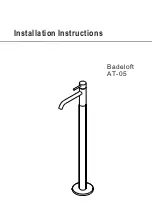
28
MANIFOLD TUBE
BRACKET
TAB
SLOT
BURNER
CLOSE-UP INSIDE VIEW OF
THE COMBUSTION CHAMBER.
FIGURE 34.
Igniter System
The STP (Spark-to-Pilot) igniter system consists of the
pilot, electrode, and wire. The pilot is ignited by an electric
spark generated when the gas control valve/thermostat
sends an electrical signal to the electrode. Use only factory
authorized STP igniter parts for replacement.
Pilot/Igniter-Flame
Sensor Bracket
Electrode
Pilot
Igniter Wire
Connection
Point
FIGURE 35.
Testing the Igniter System
Turn off the gas to the water heater at the manual gas
shut-off valve. Watch the electrode tip while activating the
igniter. A visible spark should jump from the electrode. To
avoid shock, do not touch the burner or any metal part
on the pilot or pilot assembly. If no spark is visible, check
the wire connections and make sure the electrode is not
broken. Replace the igniter if defective. Dirt and rust on the
pilot or electrode tip can prevent the igniter spark. Wipe
clean with a damp cloth and dry completely. Rust can be
removed from the electrode tip and metal surfaces by
lightly sanding with an emery cloth or fine grit sandpaper.
Removing and Replacing the Gas Control
Valve/Thermostat
IMPORTANT: This water heater has a resettable thermal
switch installed. Do not attempt to disable or modify this
feature in any way. Use only factory authorized
replacement parts.
Removing the Gas Valve:
1. Turn off the gas supply to the water heater at the
manual gas shut-off valve. This valve is typically
located beside the water heater. Note the position of
the shut-off valve in the open/on position then proceed
to turn it off (Figure 5).
2. Move the ON/OFF switch on the gas control valve/
thermostat to the “OFF” position to turn off the water
heater and unplug from the wall outlet. (Figure 27).
3. Drain the water heater. Refer to the section of “Drain-
ing and Flushing” section and follow the procedure.
5. Disconnect the wire harness, flammable vapor sen-
sor wires, and igniter wire from the gas control valve/
thermostat. Disconnect pilot tube (7/16” wrench) and
manifold tube (3/4” wrench) at the gas control valve/
thermostat (Figure 26).
NOTE:
L.P. Gas systems use
reverse (left-hand) threads on the manifold tube
6. Refer to “Gas Piping” section (Figure 5) and disconnect
the ground joint union in the gas piping. Disconnect the
remaining pipe from the gas control valve/thermostat.
7. To remove the gas control valve/thermostat, thread a
4” section of pipe into the inlet and use it to turn the
gas control valve/thermostat (counterclockwise.) Do
not use pipe wrench or equivalent to grip body. Dam-
age may result, causing leaks. Do not insert any sharp
objects into the inlet or outlet connections.
Damage to the gas control valve/thermostat may result.
Replacing the Gas Valve:
1. To replace the gas control valve/thermostat, reassemble
in reverse order. When replacing the gas control valve/
thermostat, thread a 4” section of pipe into the inlet and
use it to turn the gas control valve/thermostat (clock-
wise.) DO NOT OVER TIGHTEN or damage may result.
NOTE: Use an approved
TEFLON
®
tape or pipe com-
pound only on the threaded section of the gas control
valve/thermostat that screws into the tank.
2. Reconnect the gas piping to the gas control valve/ther-
mostat. NOTE: Use an approved Teflon tape or pipe
compound on the gas piping connections.
3. Do not use the (pilot) ferrule nut supplied with the new
gas control valve/thermostat, unless the existing nut
is not usable. Reconnect the manifold tube, pilot tube,
igniter wire, wiring harness, and thermal switch wires.
NOTE: L.P. gas systems use reverse (left-hand) threads
on the manifold tube.
4. Fill the tank completely with water. NOTE: To purge the
lines of any excess air, keep the hot water faucet open
for 3 minutes after a constant flow of water is obtained.
5. Turn on the gas supply and test the gas supply con-
nections by brushing on an approved noncorrosive
leak detection solution. Bubbles forming indicate a
leak. Correct any leak found.
6. Check the operation of the burner by following the
lighting instructions on the front of the water heater.
With the burner lit, check the gas control valve/thermo-
stat supply line, manifold tube and pilot tube connec-
tions for leaks.
7. Verify proper operation and then replace the outer door.
8. If additional information is required, contact Residential
Technical Assistance by referencing the number on the
water heater.
TEFLON
®
is a registered trademark of E.I. Du Pont De Nemours and Company.













































